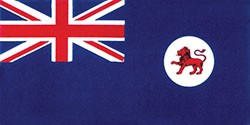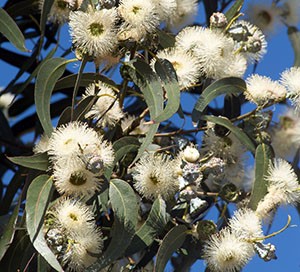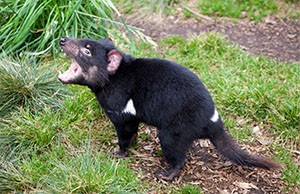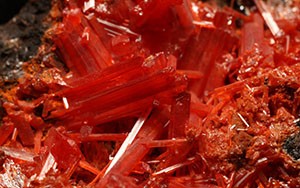The flag
A red lion, with one paw raised, stands in a circular white badge on the blue ensign to form Tasmania’s state flag, which was proclaimed in 1975. The flag originated in a proclamation made by Queen Victoria in 1876 that “the distinguishing flag or ensign of the colony for vessels belonging to or permanently employed by the Government of Tasmania shall be a blue ensign with a red lion ‘passant’ on a white shield in the fly”.
The colour references for the flag are:
- Blue: PANTONE® 286, and
- Red: PANTONE® 485.

The Coat of Arms
King George V granted Tasmania its Coat of Arms in 1917, which was later proclaimed in 1919.
The central shield in Tasmania’s Coat of Arms is supported by 2 Tasmanian tigers or thylacines. These carnivorous marsupials were regularly represented in First Nations Australians rock art and Dreaming Stories. Sadly, they are now believed to have been extinct since 1936 when it was documented that the last known living thylacine died in Hobart Zoo. Unconfirmed sightings have been regularly reported in the decades since.
Within the shield are a branch of hops, a plant whose cones are used for beer‑making; a sheaf of wheat (Tasmania was the breadbasket of Australia’s early colonies) representing agriculture; a ram illustrating the wool industry; and apples for the then “Apple Isle”. A thunderbolt refers to Tasmania’s hydro‑electric power system.
On the crest, the red lion holds a pick and shovel to represent the state’s mining industry.
Motto on Arms
Tasmania’s motto is
Ubertas et fidelitas:
“Fruitfulness and faithfulness”.

The floral emblem
The Tasmanian blue gum (Eucalyptus globulus)
The Tasmanian blue gum was proclaimed as the state’s floral emblem in 1962.
Towering to 60 metres, the Tasmanian blue gum is one of Australia’s most valuable native trees and perhaps the world’s best‑known eucalyptus.
Its upper trunk is smooth and grey‑white where the bark peels off in long, red‑brown ribbons. The lower bark clings to the tree and is rough, with deep furrows.
When it is seasoned, the wood is prized for heavy construction work such as wharves, bridges and railway sleepers, as it is very durable in the ground and in water.
The tree flowers in early summer when the leaves are abuzz with bees collecting nectar from its large, creamy‑white, woody flowers, which can be up to 2 centimetres round.
Fast‑growing Tasmanian blue gums are commonly cultivated throughout the Mediterranean region and in the highlands of the tropics in many parts of Africa and India, where it is used to replace areas denuded of their original tree cover. The tree is also grown in plantations in temperate South America, China, Spain and Sub‑Saharan Africa, as a source of fast growing straight grained hardwood in lands where all existing timber has been taken or hardwoods are non‑existent.


The animal emblem
Tasmanian devil
Tasmania proclaimed the Tasmanian devil (Sarcophilus harrisii) as its animal emblem in 2015. It is known as purinina by First Nations Australians. The Tasmanian devil is the world’s largest extant marsupial carnivore. Until 2006 they were only found on the island state of Tasmania. At that time they became a threatened species as a result of the Tasmanian Devil Facial Tumour Disease being diagnosed and acknowledged as a serious threat. Since then, a number of Tasmanian devils (small breeding populations) have been moved to wildlife parks and zoos on the Australian mainland as a means of maintaining secure populations offshore. In the meantime, research continues to find a cure for the disease.
The Tasmanian devil is recognised around the world as uniquely Tasmanian and in choosing it as the state’s animal emblem it was hoped this would promote awareness and support for the long term conservation and research efforts for this iconic species.

The mineral emblem
Crocoite
Tasmania proclaimed Crocoite as a formal symbol in 2000, due to its close association with Tasmania. Crocoite is composed of lead, chromium and oxygen. It is usually bright orange-red to blood-red and can occur in lustrous crystals. Some of the best examples are found in the Dundas area of Tasmania. While it has only minor value as an ore of lead or chromium, it is rare and highly valued in its natural state, particularly in lapidary circles and much admired worldwide.

For further information on the symbols of Tasmania, and for permission to reproduce Tasmania’s insignia, please contact:
Department of Premier and Cabinet
GPO Box 123
Hobart TAS 7000
Phone: 03 6270 5667
Email: protocol@dpac.tas.gov.au
